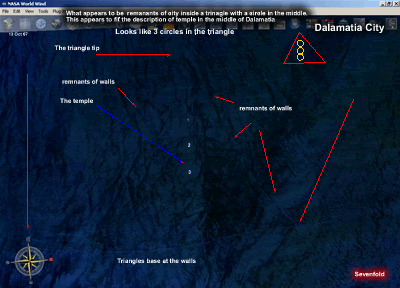Pictures originate from this blog
http://jesusdynasty.com/blog/category/talpiot-jesus-family-tomb/
The Talpiot Tomb Facade
Since the Talpiot tomb story broke into the news two months ago I have received thousands of e-mails asking, suggesting, and commenting on every possible aspect of the subject. Of all the topics related to the tomb, twenty of which I recently surveyed on this Web site, I have yet to post anything on the one that has received the most comment, namely the significance of the unusual facade on the face of this tomb–the Chevron with the circle in the center. As it turns out this very post, put up two days ago, has triggered a flood of further e-mails with even more suggestions. It has been somewhat amazing to me how this subject seems to elicit such imaginative and impassioned responses. I thought I would continue to gather these for a bit, adding to this post, and then offer what I hope will be a more historical analysis that will place this symbol in its proper historical context. That is not to say that later representations have no value, since symbols by their very nature can reflect certain more generic representations and be carried and adapted cross culturally and down through time. However, it is important to realize that we are talking here about a 1st century CE Jewish tomb in Greco-Roman Jerusalem.
This photo of the front of the tomb, taken by Amos Kloner, in March, 1980 has been reproduced thousands of times in print and on the Web. In fact, long before the Talpiot tomb began to draw news Professor Kloner chose this photo of this particular tomb for the cover of his comprehensive book in Hebrew, The Necropolis of Jerusalem in the Second Temple Period, written with Boaz Zissu (Jerusalem: Israel Exploration Society, 2003), which is just now coming out in English published by Peeters. It is clearly quite striking. But what does it mean, and what might it tell us about this now famous 1st century Jewish family tomb?
The Chevron symbol itself has a rich history and is associated with the rafter of a building, the entrance of a gate, or the notion of building in general. It is a symbol common to heraldry. I thought it might be interesting to my readers to see a rundown on some of the many and varied suggestions that have come to me. I know there are many more proposals on the Web that I have not included here. Some of these seem to have some real merit and others I think are probably quite far out but I will offer them without comment or interpretation for now, but as a prelude to a full discussion of the tomb symbol and what it likely meant in pre-70 CE 1st century Jerusalem. They are in no particular order:

1st Century CE triclinium Mosaic at Pompei

Master Masonic Apron from Europe

General Masonic Builders Symbol

Coin of Herod Philip II (4 BCE to 34 CE) with a common Temple facade, in this case possibly the Nicanor Gate in Jerusalem

Ossuary Lid Reflecting the Idea of a Roof or Temple/House for the Bones

Gravestone of a Christian named Datus, 3rd Century CE, Catacombs, Rome: Jesus Raising Lazarus


Early Christian Fish Symbol

Various Forms of the All-Seeing Eye: Here Carucci’s Supper at Emmaus with Resurrected Jesus

General Masonic Symbol

Facade of the 1st century CE “Tomb of the Sanhedrin” in Sanhedria, Jerusalem

Stonework at Mary Magdalene Church in Suffolk, England

Pilate Washing His Hands, Early Christian Fresco

A Cryptic Representation of the Star of David
Further suggestions from readers who have not provided images:
The Hebrew letters Dalet and Ayin in Paelo-Hebrew: Symbolizing the idea of the Door & the Eye
Female Sexual Organs
Gothic Church Architecture
A Jewish Wedding Chuppah with a Unity Symbol
Spirit Descending Anointing the Head of the Messiah






more seals













